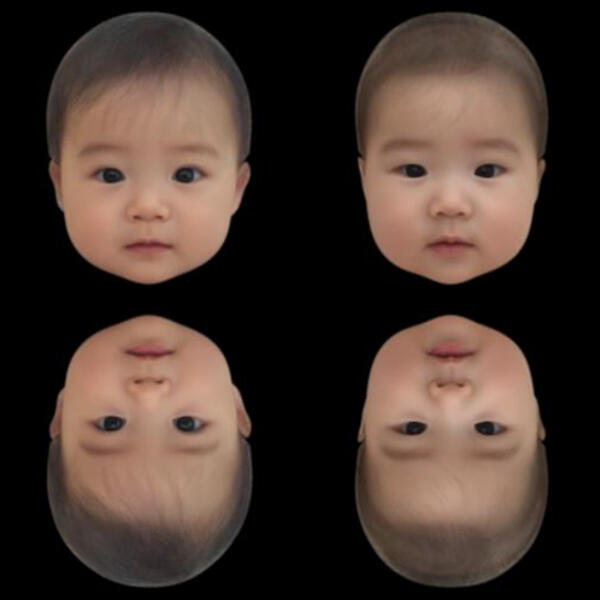Although a viewer's impression of a face changes dramatically when the face is presented in an inverted manner, the cuteness of an infant's face does not. An online experiment conducted by the research group led by Assistant Professor Kana Kuraguchi (currently Lecturer of the Faculty of Humanities and Social Sciences at Shitennoji University) and Professor Hiroshi Nittono of the Graduate School of Human Sciences at Osaka University, has revealed that the cuteness of infant faces is perceived regardless of the orientation of the face images (inverted or upright). This is because the cuteness of infant faces is perceived based on the physical features of the individual parts of the face, such as the roundness of the contour and large size of the eyes, rather than on the facial structure (subtle spatial relationships among facial parts). This study was published in the online early-release version of the journal Perception.

Creation and Validation of the Japanese Cute Infant Face (JCIF) Dataset, Nittono et. al., https://doi.org/10.3389/fpsyg.2022.819428. CC by 4.0
Humans tend to perceive features such as a rounded facial contour, broad forehead, and large eyes as cute. This phenomenon and the concept of baby schema were proposed by the animal behaviorist Konrad Lorenz approximately 80 years ago. However, human faces are more difficult to recognize when inverted (face inversion effect).
This phenomenon has been considered to be evidence that the spatial relationship among facial parts, rather than the features of individual parts, is crucial for face perception.
Lorenz proposed that the perception of "cuteness" of infants' face is influenced by individual elemental features, such as a rounded face and large eyes. If this idea is correct, then the face inversion effect reported in adult faces may not apply to the perception of "cuteness" of infant faces. In response, the research group tested whether the perception of the "cuteness" of infant faces changed when face images were presented in an inverted manner.
Their online experiment included 299 Japanese men and women aged 20−71 years. The participants were shown one image each from six faces with high average "cuteness" ratings and six faces with low average "cuteness" ratings from among 12 computer-synthesized face images of 6-month-old infants. The participants were then asked to rate the "cuteness" of each face image on a 7-point scale.
Next, the participants were shown nine pairs of different synthesized faces, with increased and decreased levels of cuteness. The participants were asked to choose which face they found to be cuter. In this experiment, one group was asked to assess face images presented in the correct orientation (upright), whereas another group was asked to assess inverted face images. For comparison, the participants were also asked to assess the "beauty" of the infants' faces based on upright and inverted images. The participants in the experiment were assigned to one of four groups.
The results of the experiment showed that the cuteness rating did not decrease even when the infants' faces were inverted. The difference between the faces in terms of high and low average cuteness ratings also remained unchanged. Furthermore, the performance for the task of selecting the cuter face among two presented faces was also higher than chance, regardless of the orientation of the face images. However, the performance was slightly lower for the inverted images. Similar results were obtained when evaluating and assessing the "beauty" of infant faces.
These results indicate that the cuteness of infant faces is perceived regardless of the face's orientation. Although the relative positions of the eyes, nose, and mouth are also used to assess slight differences in cuteness, cuteness is primarily perceived based on features of the individual parts of the face (e.g., rounded facial contours and large eyes). This finding is consistent with Lorenz's baby schema concept and its effect.
The results of this study suggest that, for example, when creating a "cute" robot or illustration, it is better to combine individual elements that are perceived as "cute" than to devise the arrangement of facial parts.
Nittono said, "One of the cues and clues that make us perceive the 'cuteness' of babies is the baby schema discussed in this study. It has been believed that the subtle arrangement among facial parts such as eyes, nose, and mouth is important for the attractiveness and beauty of adult faces. However, the present study confirmed that the perception of "cuteness" is based on relatively simple physical features. Therefore, as long as these features are included, it is possible to make people perceive "cuteness" even if an image does not look like a face."
Journal Information
Publication: Perception
Title: Face inversion effect on perceived cuteness of infant faces
DOI: 10.1177/03010066231198417
Publication: Frontiers in Psychology
Title: Creation and Validation of the Japanese Cute Infant Face (JCIF) Dataset
DOI: 10.3389/fpsyg.2022.819428
This article has been translated by JST with permission from The Science News Ltd. (https://sci-news.co.jp/). Unauthorized reproduction of the article and photographs is prohibited.




